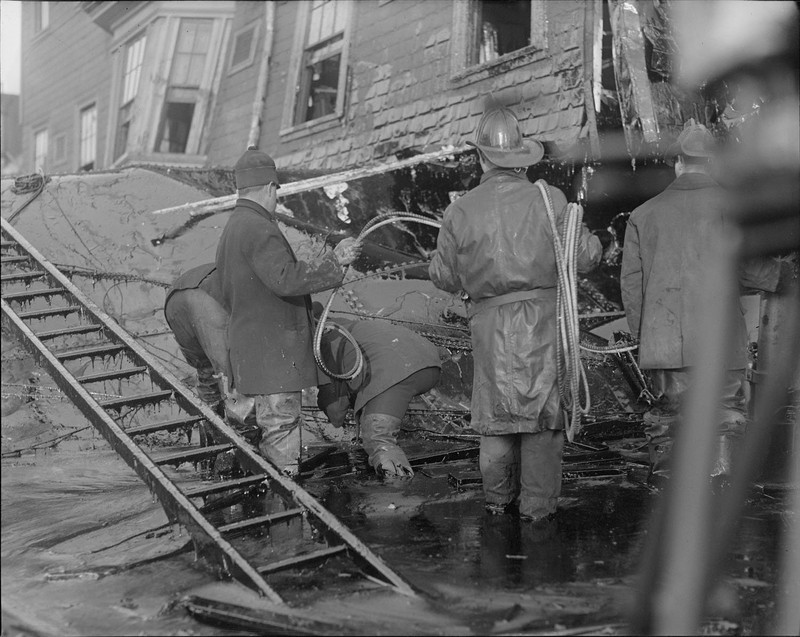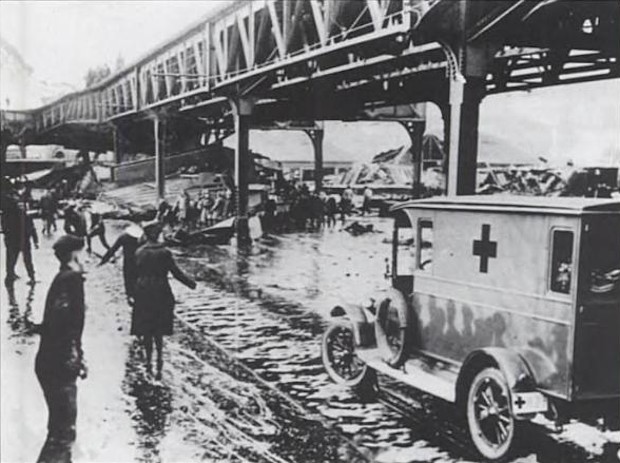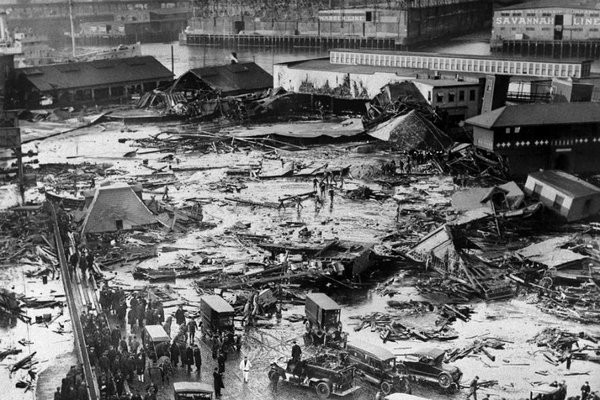The Great Boston Molasses Flood Plaque
Introduction
Text-to-speech Audio
Images
The site of the Boston Molasses Flood Plaque in the North End of Boston. Source: thechelseascrolls.com

Firemen standing in knee-deep molasses while searching for survivors. Source: northendwaterfront.com

Ambulances rushing to the scene of the explosion through the molasses wreckage. Source: http://mentalfloss.com

The ruins left after the 2.3 million gallon tank of molasses exploded and ravaged part of the city of Boston. Source: www.csmonitor.com

Backstory and Context
Text-to-speech Audio
At approximately 12:45 on the abnormally warm day of January 15, 1919, the massive USIA company tank of molasses burst, resulting in a two-story tall wave of molasses that carried 2.3 million gallons of molasses with it. The tank, a five-story tall, 90 feet in diameter contraption holding 2,600,000 pounds of molasses, erupted with such force that molasses travelled across the city of Boston at speeds just above 35 miles per hour (Atlas Obscura). As the Boston Globe of the time wrote: “the force of the molasses wave caused buildings to cringe up as though they were made of pasteboard” (history.com). The sheer force of the wave was also enough to tear a train apart, along with many buildings that it passed by and through. Witness John Mason wrote that “the four loaded freight cars were washed like chips down the track. The half-loaded car was caught on the foaming crest of the eight foot wave and, with unbelievable force, hurled through the corrugated iron walls of the terminal” (Mason). After months of assessment, the property damage resulting from this explosion totaled $100,00,000 in today’s currency (Mass Monuments), as it destroyed almost everything within a two-block radius and also created damage that extended beyond those limits.
Along with the material damage, the personal damage was just as terrible. Those closest to the explosion were most vulnerable to injury and death, for once individuals were trapped in the molasses, it became difficult for rescue squads to reach them. As reported by the Boston Herald on January 16, the day after the explosion, “Some of the injured, as most of the dead, were dug from beneath the wreckage and congealing molasses with bodies maimed and mutilated” (Boston Herald). Although troops of firemen and police rushed as fast as they could to help, the process was slow due to the thickness of the molasses was in the area. Those who were injured were first treated “at the Haymarket Square Relief Hospital, and from there many were transferred to the City Hospital” (Boston Herald). Not only humans, but many animals, were stuck in, or killed by the molasses. For instance, horses were described as “dying like flies on fly paper” by the Boston Post (The Boston Post).
The exact reason for the tank explosion was never exactly understood, although there has been much research and scientific inquiry into this question. The over 120 lawsuits that resulted from this incident made it imperative that the blame fall on somebody, most likely the company itself (history.com). As research was conducted and people were questioned, it became clear that the tank had always made strange groaning sounds depending on the temperature and how much it was holding at any given time. In many accounts it was noted that the citizens of the area were so accustomed to these noises that, at the time of the incident, no one thought anything of it (Life Science).
Nicole Sharp, a modern researcher, along with a few other scientists did research that determined that, due to a new, warm load of molasses that had just been imported and poured into the tank the day before onto the resting cold molasses already in the tank, the drastic difference in temperature and potential overloading of the tank most likely had something to do with the explosion (Life Science).
In addition, information later surfaced that, because the company was in such a rush to finish the tank’s construction in 1915, “the strength of the tank was not tested before it was filled. To avoid costly interruptions in the molasses distilling process, the manager ignored employees and others who warned that the tank was unsound” (history.com). Although all of this information leads directly back to the company and its mistake, the company argued that the tank had been “sabotaged,” via bombing, according to an article published in The Daily Boston Globe of the time. The company blamed Italian anarchist groups, which had at the time been accused of many bombings. The USIA had even received an anonymous call from someone who actually “threatened to destroy the tank with dynamite” (history.com). Nonetheless, the USIA was found guilty and ended up paying millions of dollars to the unhappy families of victims of the flood.
It was said by witness Edward Park that the area smelled of molasses for months after the incident. Even after the smell was gone, the memory of this event lingered on for many decades after, and the devastation it brought about was never forgotten. Nonetheless, to ensure the memory of The Great Molasses Flood, this plaque was installed. Although it is a small marker, it stands as a reminder of the chaos of the flood and, more importantly, what could happen if small technical flaws are overlooked.
Cite This Entry
Lauren Stikeleather. "The Great Boston Molasses Flood Plaque." Clio: Your Guide to History. November 26, 2017. Accessed August 16, 2025. https://theclio.com/entry/48289
Sources
"Disaster Attributed to Fermentation." The Boston Herald(Boston), January 16, 1919, 16 ed, 1-1.
"Death and Devastation in Wake of North End Disaster." The Boston Daily Globe(Boston), 95 ed, 1-22.
Mason, John. The Molasses Disaster of January 15, 1919. Eric Postpischil's Molasses Disaster Pages. Accessed November 02, 2017. http://edp.org/molyank.htm. Republished by Yankee Magazine in 1965
Great Molasses Flood. Mass Moments. Accessed November 02, 2017. https://www.massmoments.org/moment-details/great-molasses-flood.html. Author and date published unknown.
Andrews, Evan. The Great Molasses Flood of 1919. The History Channel. January 13, 2017. Accessed November 03, 2017. http://www.history.com/news/the-great-molasses-flood-of-1919.
Choi, Charles Q. Great Molasses Flood of 1919: Why This Deluge of Goo Was So Deadly. Life Science. November 21, 2016. Accessed November 02, 2017. https://www.livescience.com/56947-why-molasses-flood-1919-was-deadly.html.
Great Boston Molasses Flood Plaque. Atlas Obscura. Accessed November 02, 2017. https://www.atlasobscura.com/places/great-boston-molasses-flood-plaque. Author and date published unknown.

